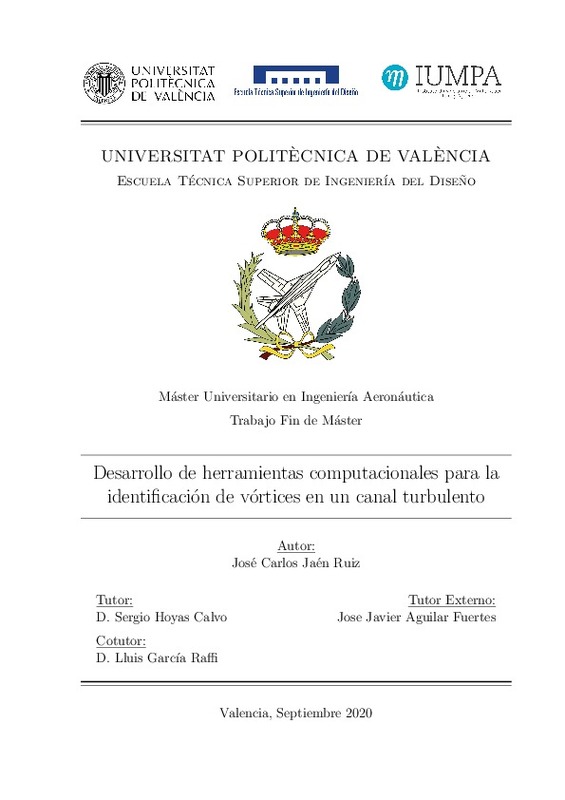JavaScript is disabled for your browser. Some features of this site may not work without it.
Buscar en RiuNet
Listar
Mi cuenta
Estadísticas
Ayuda RiuNet
Admin. UPV
Desarrollo de herramientas computacionales para la identificación de vórtices en un canal turbulento
Mostrar el registro sencillo del ítem
Ficheros en el ítem
| dc.contributor.advisor | Hoyas Calvo, Sergio
|
es_ES |
| dc.contributor.author | Jaén Ruiz, José Carlos
|
es_ES |
| dc.date.accessioned | 2020-10-14T06:31:39Z | |
| dc.date.available | 2020-10-14T06:31:39Z | |
| dc.date.created | 2020-09-18 | |
| dc.date.issued | 2020-10-14 | es_ES |
| dc.identifier.uri | http://hdl.handle.net/10251/151666 | |
| dc.description.abstract | [ES] El principal objetivo de este Trabajo Final de Máster es el desarrollo de herramientas que nos permitan identificar vórtices en simulaciones numéricas directas, DNS. Para ello se ha hecho uso de distintos algoritmos implementados en Fortran, paralelizados mediante MPI y OpenMP. A partir de los resultados obtenidos por el código LISO (encargado de resolver la DNS), se identifican los puntos que superan un cierto criterio de vorticidad, generando así una matriz booleana. En primer lugar, se ha desarrollado un algoritmo de identificación de estructuras, el cual divide el dominio entre todos los procesadores, y se hace la identificación a partir de encontrar un punto de origen del vórtice, y recorriéndolo en las 6 direcciones cartesianas. Cuando todos los procesadores han hecho su identificación, se unifican los resultados identificando los vórtices totales del campo. Una vez tenemos los vórtices identificados en cada instante temporal, se hace el seguimiento temporal de los mismos. Para ello se comparan las estructuras en dos instantes temporales consecutivos, determinando la evolución, vida, muerte, rotura o coalescencia de los vórtices. Finalmente, estas herramientas han sido implementadas como un módulo del código LISO, realizando la identificación y seguimiento de los vórtices al mismo tiempo que se realiza la simulación numérica directa del canal turbulento. | es_ES |
| dc.description.abstract | [CA] El principal objectiu d’aquest Treball Final de M`aster ´es el desenvolupament de ferramentes que ens permeten identificar v`ortexs en simulacions num`eriques directes, DNS. Per a aix`o s’ha fet ´us de distints algoritmes implementats en Fortran, parallelitzats per mitj`a de MPI i OpenMP. A partir dels resultats obtinguts pel codi LISO (encarregat de resoldre la DNS), s’identifiquen els punts que superen un cert criteri de vorticitat, generant aix´ı una matriu booleana. En primer lloc, s’ha desenvolupat un algoritme d’identificaci´o d’estructures, el qual dividix el domini entre tots els processadors, i es fa la identificaci´o trobant un punt d’origen del v`ortex, i recorrent-ho en les 6 direccions cartesianes. Quan tots els processadors han fet la seua identificaci´o, s’unifiquen els resultats identificant els v`ortexs totals del camp. Una vegada tenim els v`ortexs identificats en cada instant temporal, es fa el seguiment temporal dels mateixos. Per a aix`o es comparen les estructures en dos instants temporals consecutius, determinant l’evoluci´o, vida, mort, ruptura o coalescencia dels v`ortexs. Finalment, estes ferramentes han sigut implementades com un m`odul del codi LISO, realitzant la identificaci´o i seguiment dels v`ortexs alhora que es realitza la simulaci´o num`erica directa del canal turbulent. | es_ES |
| dc.description.abstract | [EN] The main objective of this Master Thesis is the development of tools that allow the identification of vortices in direct numerical simulations (DNS). For that purpose, different algorithms implemented in Fortran has been used and parallelized using MPI and OpenMP. From the results obtained from LISO code (focused on solving DNS), points that accomplish a certain vorticity criterion are identified with which a boolean matrix is generated. First, a vortex identification algorithm has been developed, which divides the domain between all the processors. Each processor identifies a germ point from which the rest of the vortex is found, traveling through it in the 6 Cartesian directions. When all the processors have made their identification, the results are unified by identifying the total vortices of the field. Once the vortices have been identified at each time step, they are tracked over time. To this end, the structures are compared in two consecutive time instants, determining the evolution, life, death, rupture or coalescence of the vortices. Finally, these tools have been implemented as a module of the LISO code, carrying out the identification and tracking of the vortices at the same time that the direct numerical simulation of the turbulent channel is carried out. | es_ES |
| dc.format.extent | 125 | es_ES |
| dc.language | Español | es_ES |
| dc.publisher | Universitat Politècnica de València | es_ES |
| dc.rights | Reconocimiento (by) | es_ES |
| dc.subject | DNS | es_ES |
| dc.subject | Vórtices | es_ES |
| dc.subject | Turbulencia | es_ES |
| dc.subject | Paralelización | es_ES |
| dc.subject | Vortex | es_ES |
| dc.subject | Turbulence | es_ES |
| dc.subject | Parallelization | es_ES |
| dc.subject.classification | INGENIERIA AEROESPACIAL | es_ES |
| dc.subject.other | Máster Universitario en Ingeniería Aeronáutica-Màster Universitari en Enginyeria Aeronàutica | es_ES |
| dc.title | Desarrollo de herramientas computacionales para la identificación de vórtices en un canal turbulento | es_ES |
| dc.type | Tesis de máster | es_ES |
| dc.rights.accessRights | Abierto | es_ES |
| dc.contributor.affiliation | Universitat Politècnica de València. Departamento de Máquinas y Motores Térmicos - Departament de Màquines i Motors Tèrmics | es_ES |
| dc.contributor.affiliation | Universitat Politècnica de València. Escuela Técnica Superior de Ingeniería del Diseño - Escola Tècnica Superior d'Enginyeria del Disseny | es_ES |
| dc.description.bibliographicCitation | Jaén Ruiz, JC. (2020). Desarrollo de herramientas computacionales para la identificación de vórtices en un canal turbulento. Universitat Politècnica de València. http://hdl.handle.net/10251/151666 | es_ES |
| dc.description.accrualMethod | TFGM | es_ES |
| dc.relation.pasarela | TFGM\135009 | es_ES |
Este ítem aparece en la(s) siguiente(s) colección(ones)
-
ETSID - Trabajos académicos [8898]
Escuela Técnica Superior de Ingeniería del Diseño






